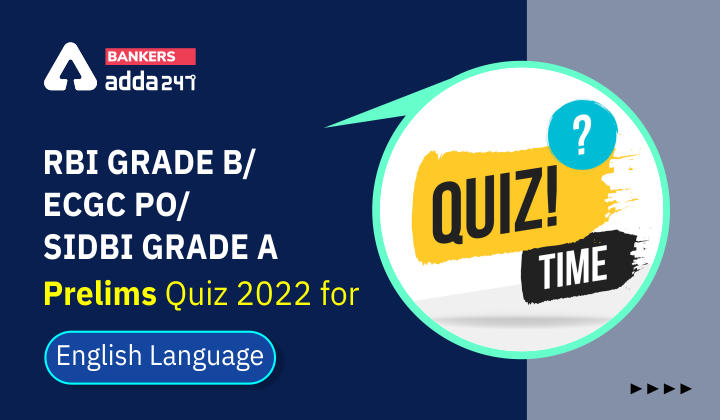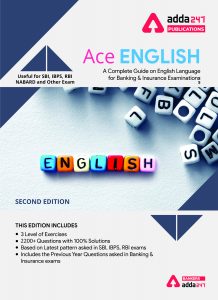Directions (1-8): Read the following passage and answer the given questions. Some words are highlighted to help you answer the questions.
BA.2 is the latest subvariant of omicron, the dominant strain of the SARS-CoV-2 virus that causes COVID-19. While the origin of BA.2 is still unclear, it has quickly become the dominant strain in many countries, including India, Denmark and South Africa. It is continuing to spread in Europe, Asia and many parts of the world. The omicron variant, officially known as B.1.1.529, of SARS-CoV-2 has three main subvariants in its lineage: BA.1, BA.2 and BA.3. The earliest omicron subvariant to be detected, BA.1, was first reported in November 2021 in South Africa. While scientists believe that all the subvariants may have emerged around the same time, BA.1 was predominantly responsible for the winter surge of infections in the Northern Hemisphere in 2021.
The first omicron subvariant, BA.1, is unique in the number of alterations it has compared to the original version of the virus – it has over 30 mutations in the spike protein that helps it enter cells. Spike protein mutations are of high concern to scientists and public health officials because they affect how infectious a particular variant is and whether it is able to escape the protective antibodies that the body produces after vaccination or a prior COVID-19 infection. Because of its relative genetic similarity, BA.2 is considered a subvariant of omicron as opposed to a completely new variant.
Some scientists have called BA.2 a “stealth” variant because, unlike the BA.1 variant, it lacks a particular genetic signature that distinguishes it from the delta variant. While standard PCR tests are still able to detect the BA.2 variant, they might not be able to tell it apart from the delta variant.
It is also considered to be more transmissible but not more virulent than BA.1. This means that while BA.2 can spread faster than BA.1, it might not make people sicker. It is worth noting that while BA.1 has dominated case numbers around the world, it causes less severe disease compared to the delta variant. Recent studies from the U.K. and Denmark suggest that BA.2 may _________(I)________ a similar risk of hospitalization as BA.1.
A recent study suggested that people previously infected with the original BA.1 subvariant have robust protection against BA.2. Because BA.1 caused widespread infections across the world, it is likely that a significant percentage of the population has protective immunity against BA.2. This is why some scientists predict that BA.2 will be less likely to cause another major wave. However, while the natural immunity gained after COVID-19 infection may provide strong protection against reinfection from earlier variants, it weakens against omicron.
Q1. The author explains the reason for why some experts believe BA.2 will have a lower chance of causing another large wave. What is it?
(a) The paragraph says so because BA.2 variant is supposedly the last variant of the Covid virus, as discovered by the scientist.
(b) BA.1 produced widespread infections over the world, therefore, it’s likely that a large proportion of population is immune to BA.2.
(c) The COVID-19 vaccination that has been distributed in most countries works efficiently to hold off the birth of a new variant.
(d) Both (a) and (c)
(e) All of the above
Q2. From the following statements, choose the incorrect statement(s) in accordance to the information given in the passage.
(i) BA.2 is classified as a subvariant of omicron rather than a wholly separate variant due to its genetic closeness.
(ii) Although BA.2 can spread more quickly than BA.1, it does not appear to make patients sicker.
(iii) BA.1, the first omicron subvariant to be detected, was discovered in November 2021 in Europe.
(a) Both (i) and (ii)
(b) Only (iii)
(c) Only (ii)
(d) Both (ii) and (iii)
(e) All of the above
Q3. Scientists and public health authorities are concerned about spike protein mutations because ____________________________________________________________________.
(a) it is unknown to mankind, throughout the scientific history, how many mutations can a single string of virus produce
(b) this mutation is something novel and never been recorded in the recent history of the Covid-19 virus.
(c) they impact how infectious a variation is and if it may evade the protective antibodies produced by the body following vaccination or infection with COVID-19
(d) All of the above
(e) None of these
Q4. Why have the scientist proclaimed that the BA.2 variant can fly under the radar while conducting the Covid evaluation?
(a) It doesn’t have a distinct genetic signature that sets it apart from the delta version.
(b) The Covid tests haven’t been refined in quality so as to be able to decent the new BA.2 variant.
(c) Scientists have concluded that this variant is milder and almost impossible to recognize when they had studied this variant meticulously.
(d) All of the above
(e) None of these
Q5. Which of the following word will be placed in the blank (I)?
(a) compound
(b) steeped
(c) implore
(d) pose
(e) None of these
Q6. Choose the synonym of STEALTH as highlighted in the passage.
(a) scrumptious
(b) militant
(c) clandestine
(d) omnipotent
(e) barren
Q7. Choose the word that is the most opposite in its meaning to DOMINANT as highlighted in the passage.
(a) industrious
(b) unceremonious
(c) secondary
(d) reverie
(e) genial
Q8. The second paragraph contains a word which means strong and healthy; vigorous. Select which word it is.
(a) infected
(b) subvariant
(c) natural
(d) weakens
(e) robust
Directions (9-15): Read the following passage and answer the given questions. Some words are highlighted to help you answer the questions.
Among the many changes brought about by the pandemic is the widespread use of QR codes, graphical representations of digital data that can be printed and later scanned by a smartphone or other device. QR codes have a wide range of uses that help people avoid contact with objects and close interactions with other people, including for sharing restaurant menus, email list sign-ups, car and home sales information and checking in and out of medical and professional appointments.
QR codes are a close cousin of the bar codes on product packaging that cashiers scan with infrared scanners to let the checkout computer know what products are being purchased. Bar codes store information along one axis, horizontally. QR codes store information in both vertical and horizontal axes, which allows them to hold significantly more data. That extra amount of data is what makes QR codes so versatile.
Like barcodes, QR codes are designed with data redundancy. Even if as much as 30% of the QR code is destroyed or difficult to read, the data can still be recovered. In fact, logos are not actually part of the QR code; they cover up some of the QR code’s data. However, due to the QR code’s redundancy, the data represented by these missing dots can be recovered by looking at the remaining visible dots.
QR codes are not inherently dangerous. They are simply a way to store data. However, just as it can be hazardous to click links in emails, visiting URLs stored in QR codes can also be risky in several ways. The QR code’s URL can take you to a phishing website that tries to trick you into entering your username or password for another website. The URL could take you to a legitimate website and deceive that website into doing something harmful, such as giving an attacker access to your account. While such an attack requires a flaw in the website you are visiting, such vulnerabilities are common on the internet. The URL can take you to a malicious website that tricks another website you are logged into on the same device to take an unauthorised action.
A malicious URL could open an application on your device and cause it to take some action. Maybe you have seen this behaviour when you clicked a Zoom link, and the Zoom application opened and automatically joined a meeting. While such behaviour is ordinarily benign, an attacker could use this to _____(II)_____ some apps into revealing your data. It is critical that when you open a link in a QR code, you ensure that the URL is safe and comes from a trusted source. Just because the QR code has a logo you recognise does not mean you should click on the URL it contains.
Q9. What does the author mean by “QR codes are designed with data redundancy”?
(a) QR codes cannot retain data, once the code has been lost or destroyed.
(b) This means that one needs to be careful and collect data before the time finishes to scan the QR code.
(c) The data can still be retrieved even if some part of the QR code is damaged or hard to interpret.
(d) Both (a) and (c)
(e) All of the above
Q10. QR codes are extremely adaptable as compared to bar codes because of ____________________________.
(a) the variety of symbols and texts they use
(b) the colour scheme is always monochromatic and black and white
(c) their nature of being portable
(d) the additional data they may hold
(e) None of these
Q11. Given below are some statements about QR codes. Choose the one(s) which provide(s) the correct information about them.
(a) QR codes may be used for a variety of purposes, including avoiding touch with items and close encounters with other people.
(b) They contain data in both vertical and horizontal axes, allowing them to retain a lot more information.
(c) QR codes and bar codes are very dissimilar in nature and cannot be compared in any context.
(d) Both (a) and (b)
(e) All of the above
Q12. Why does the author ask the users and readers to exercise caution while dealing with OR codes?
(a) QR codes might cause power failure to the device you might be accessing them on.
(b) A fraudulent URL might lead your device to launch an application and perform an activity.
(c) The URL of the QR code may redirect you to a fake website that attempts to mislead you into entering your login or password for yet another website.
(d) Both (b) and (c)
(e) All of the above
Q13. The last paragraph includes a word which means a condition, tumour, or growth that is not cancerous. Which one of the following is it?
(a) benign
(b) critical
(c) malicious
(d) URL
(e) source
Q14. Which of the following word will be placed in the blank (II)?
(a) postpone
(b) trick
(c) tax
(d) deduce
(e) quail
Q15. Choose the synonym of PURCHASED as highlighted in the passage.
(a) procured
(b) wounded
(c) outdone
(d) rectified
(e) exhorted
Solutions
S1. Ans (b)
Sol. The correct answer is option (b): BA.1 produced widespread infections over the world, therefore, it’s likely that a large proportion of population is immune to BA.2.
The answer can be found in the last paragraph where it states: Because BA.1 caused widespread infections across the world; it is likely that a significant percentage of the population has protective immunity against BA.2. This is why some scientists predict that BA.2 will be less likely to cause another major wave.
S2. Ans (b)
Sol. The correct answer is option (b): Only (iii).
This statement is incorrect because the first paragraph states: The earliest omicron subvariant to be detected, BA.1, was first reported in November 2021 in South Africa.
Statement (i) is correct because the last line of second paragraph mentions: Because of its relative genetic similarity, BA.2 is considered a subvariant of omicron as opposed to a completely new variant.
The same way statement (ii) is correct because the third paragraph says: This means that while BA.2 can spread faster than BA.1, it might not make people sicker.
S3. Ans (c)
Sol. The correct answer is option (c): they impact how infectious a variation is and if it may evade the protective antibodies produced by the body following vaccination or infection with COVID-19.
This answer is present in the second paragraph: Spike protein mutations are of high concern to scientists and public health officials because they affect how infectious a particular variant is and whether it is able to escape the protective antibodies that the body produces after vaccination or a prior COVID-19 infection.
S4. Ans (a)
Sol. The correct answer is option (a): It doesn’t have a distinct genetic signature that sets it apart from the delta version.
The third paragraph mentions the answer to this question: Some scientists have called BA.2 a “stealth” variant because, unlike the BA.1 variant, it lacks a particular genetic signature that distinguishes it from the delta variant.
S5. Ans (d)
Sol. The correct answer is option (d): pose.
Pose means to be present or constitute (a problem or danger).
Compound- to put together (parts) so as to form a whole; combine.
Steeped- surround or fill with a quality or influence.
Implore- beg someone earnestly or desperately to do something.
S6. Ans (c)
Sol. The correct answer is option (c): clandestine.
Clandestine means undertaken or done so as to escape being observed or known by others.
This can serve as a synonym of stealth.
Scrumptious- (of food) extremely tasty; delicious.
Militant- combative and aggressive in support of a political or social cause, and typically favouring extreme.
Omnipotent- (of a deity) having unlimited power; able to do anything.
Barren- (of a place or building) bleak and lifeless.
S7. Ans (c)
Sol. The correct answer is option (c): secondary.
Secondary means coming after, less important than, or resulting from someone or something else that is primary.
Industrious- diligent and hard-working.
Reverie- a state of being pleasantly lost in one’s thoughts; a daydream.
Unceremonious- having or showing a lack of courtesy; rough or abrupt.
Genial- friendly and cheerful.
S8. Ans (e)
Sol. The correct answer is option (e): robust.
Robust means having or exhibiting strength or vigorous health.
damaged or hard to interpret.
S9. Ans (c)
Sol. The correct answer is option (c): The data can still be retrieved even if some part of the QR code is
This answer is present in the second paragraph itself: Like barcodes, QR codes are designed with data redundancy. Even if as much as 30% of the QR code is destroyed or difficult to read, the data can still be recovered.
S10. Ans (d)
Sol. The correct answer is option (d): the additional data they may hold.
The answer is in the last line of the first paragraph: Bar codes store information along one axis, horizontally. QR codes store information in both vertical and horizontal axes, which allows them to hold significantly more data. That extra amount of data is what makes QR codes so versatile.
S11. Ans (d)
Sol. The correct answer is option (d): Both (a) and (b).
Both the statements are present in the first paragraph: (a) QR codes have a wide range of uses that help people avoid contact with objects and close interactions with other people, including for sharing restaurant menus, email list sign-ups, car and home sales information and checking in and out of medical and professional appointments.
(b) QR codes store information in both vertical and horizontal axes, which allows them to hold significantly more data.
Statement (c) is incorrect because the first paragraph mentions: QR codes are a close cousin of the bar codes on product packaging that cashiers scan with infrared scanners to let the checkout computer know what products are being purchased.
S12. Ans (d)
Sol. The correct answer is option (d): Both (b) and (c).
Statement (c) is present in the third paragraph: The QR code’s URL can take you to a phishing website that tries to trick you into entering your username or password for another website.
Statement (b) is present in the last paragraph: A malicious URL could open an application on your device and cause it to take some action.
S13. Ans (a)
Sol. The correct answer is option (a): benign.
A condition is called benign to suggest it is not dangerous or serious.
S14. Ans (b)
Sol. The correct answer is option (b): trick.
To trick someone means to fool someone; to deceive someone; to cheat someone.
S15. Ans (a)
Sol. The correct answer is option (a): procured.
Procure means to obtain (something), especially with care or effort.
Wound- inflict an injury on (someone).
Outdo- be more successful than.
Rectify- put right; correct.
Exhort- strongly encourage or urge (someone) to do something.





 GA Capsule for SBI Clerk Mains 2025, Dow...
GA Capsule for SBI Clerk Mains 2025, Dow...
 The Hindu Review October 2022: Download ...
The Hindu Review October 2022: Download ...
 Test Prime Subscription by Adda247
Test Prime Subscription by Adda247


